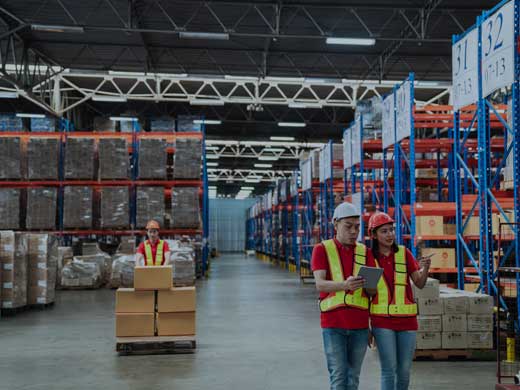Your food and beverage SME has always been vulnerable to supply chain disruptions.
Labor shortages and productivity challenges
For example, finding skilled people for your team has not been, and will not be, easy. For many companies, this labor shortage has already led to reduced working hours, unfilled customer orders, diminishing product/service quality or output, and a resulting drop in competitiveness. The fact that the food and beverage sector has traditionally been slow to adopt automated solutions has not facilitated matters.
Upstream from your food and beverage plant, farmers that may be supplying some of your raw materials face similar challenges. Recruiting capable labour in low-population agricultural regions is difficult.
Scarcity of raw materials
Container congestion at the ports has increased the demand for trucking. This demand drives up prices for trucking capacity.
So if, for example, your Canadian SME imports cheese by container from Europe, your business will need to adapt on several fronts. On top of the regular lead time, you now have to add 30 to 45 days because the container is stuck on a ship outside a port or on a dock because there isn’t enough staff to unload the ship.
If such a delay can’t be easily planned for, the cheese shortage in your inventory may lead to a shutdown of a line of production. Your salespeople will have to turn down orders. Your purchasing manager may inform you that other companies stocked up heavily on cheese, which worsened the shortage.
To salvage some sales, you may try to squeeze some cheese out of a distributor with whom you typically have cordial relations. That pressure corners your distributor who, facing the same shortage, is trying to make as many customers happy as possible. All these pressures acting on the players in the supply chain leave no one happy, including the retailer and the shopper faced with an empty grocery shelf.

How can you make your business less vulnerable to supply chain disruptions?
To respond to these supply chain challenges, several courses of action are available to you, with varying degrees of long-term ROI. Consider the following options:
Set up backup sourcing options, either with other vendors from the same part of the world or with vendors in other regions, making sure, of course, that they can comply with your food safety guidelines. You also need to ensure you have lined up the transportation logistics that will enable you to get the goods when you change vendors quickly.
Pay a premium to accelerate delivery of delayed raw materials and components, or be ready to pay overtime wages to catch up in production.
Reinstate deactivated production lines to boost production.
Invest in e-commerce capability so you can go directly to the customer and detour any distribution channel that may be slowing access to your market. If on-shelf prices stay stable, your e-commerce investment would take a short- to medium-term bite out of your margins.
Use new technologies, such as an Enterprise Resource Planning (ERP) system, to get better visibility into your operation and automate your supply chain planning.
You can’t avoid all supply chain disruptions but an ERP system empowers your business to minimize their impact. We discuss below four key ways an ERP system can help you do that. But first, let’s define what an ERP is.
What is an ERP system?
In an ERP system, each of your business functions has a software module dedicated to it. These modules standardize all the data of that function and then integrate it into a centralized database that organizes all your business’ data in real time.
As a result, the ERP system offers you real-time visibility into all your operations and the ability to instantly create planning and forecasting scenarios based on the variables you’re interested in. Thus, you can make better, faster decisions to adapt to a quickly changing environment.
To learn more about the fundamentals of an ERP system, please click on our article, “What is an ERP? Your Most Common Questions are Answered Here”

Supported by an ERP system, you can minimize the impact of supply chain disruptions because you can do the following:
1. Plan and forecast better
With full visibility into inventory, sales, and production, your leaders can plan with precision what raw materials you need to purchase, which equipment will be operating, and the staff it takes to fulfill your commitments.
As a result of this precision planning, you produce more efficiently, more quickly, with just the right amount of staff, so you can avoid production slowdowns, overtime, equipment breakdowns, and other issues that arise with more traditional methods of planning.
As noted earlier, your ERP’s forecasting capacity enables you to explore various production scenarios as your production variables evolve.
2. Connect easily to a Third-Party Logistics (3PL) provider
Let’s say demand for your products leads you to consider expanding your warehousing capacity. Yet, that customer demand is highly variable. Do you invest in finding what may be rare or expensive warehouse space, then recruiting, training, and paying more staff?
Or, do you use a 3PL provider to whom you can outsource flexibly whatever distribution, warehousing, transportation, and fulfillment services you need?
If you decide on the 3PL solution, your ERP system enables you to keep tabs on the third-party warehouse as if it were under your own roof. What’s more, you can send customer orders instantly to the fulfillment staff in place. They, in turn, can input the inventory and shipping information directly into your ERP, so you’re always looking at an up-to-date status of your operation.
3. Easily pass on supplier price increases in your own prices
How can you protect your margins when the cost of raw materials and components fluctuates dynamically? By basing your pricing on your ERP’s real-time costing model.
As raw materials arrive in your building, your team can input their real costs into your ERP’s costing model. So when you analyze your margins in real time, you can act proactively to make the necessary product pricing adjustments.
Furthermore, if you want to run simulation scenarios with different costs in your costing module, your ERP enables you to easily see the impact on your pricing and margins.
4. Take advantage of transportation optimization systems
With an ERP supporting your business, you can take advantage of many digital tools to enhance your productivity. For example, today’s transportation optimization systems (TMS) analyze shipments, rates and other logistical constraints to produce delivery plans that optimize your cost-efficiency and delivery efficacy.
Because your ERP system can easily be connected to a TMS, you can:
- Optimize routes to lower transportation costs.
- Find the cheapest carrier for a given destination based on shipment volume.
- Connect to your ERP costing module to include transport costs in your margin analysis and better plan your shipments.
- Calculate the transportation costs of a marketplace, such as Amazon, to ensure that the Amazon purchase price fairly reflects your actual costs.
As a food and beverage business, you will always be affected by disruptions in your supply chain. But you can minimize these impacts with an ERP system. It empowers your team with functionalities that facilitate precise planning, deep insight into your pricing and margins, and easy connection to tools and service providers that can improve your productivity.
If you’d like more information on what an ERP system can do to help minimize the impact of your food and beverage supply chain challenges, connect with us today!





